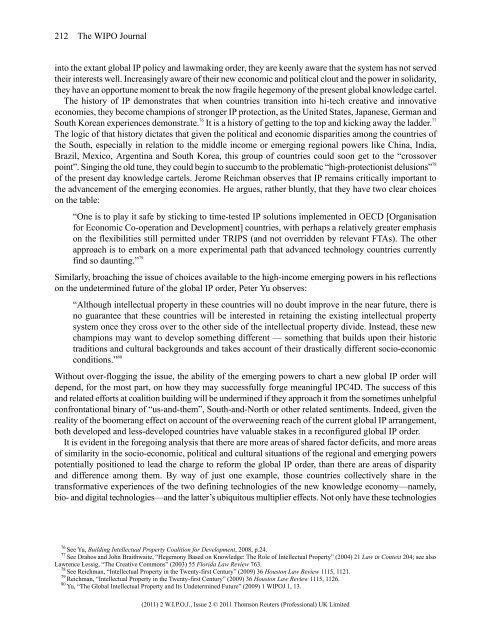WIPO Journal - World Intellectual Property Organization
WIPO Journal - World Intellectual Property Organization
WIPO Journal - World Intellectual Property Organization
Create successful ePaper yourself
Turn your PDF publications into a flip-book with our unique Google optimized e-Paper software.
212 The <strong>WIPO</strong> <strong>Journal</strong><br />
into the extant global IP policy and lawmaking order, they are keenly aware that the system has not served<br />
their interests well. Increasingly aware of their new economic and political clout and the power in solidarity,<br />
they have an opportune moment to break the now fragile hegemony of the present global knowledge cartel.<br />
The history of IP demonstrates that when countries transition into hi-tech creative and innovative<br />
economies, they become champions of stronger IP protection, as the United States, Japanese, German and<br />
South Korean experiences demonstrate. 76 It is a history of getting to the top and kicking away the ladder. 77<br />
The logic of that history dictates that given the political and economic disparities among the countries of<br />
the South, especially in relation to the middle income or emerging regional powers like China, India,<br />
Brazil, Mexico, Argentina and South Korea, this group of countries could soon get to the “crossover<br />
point”. Singing the old tune, they could begin to succumb to the problematic “high-protectionist delusions” 78<br />
of the present day knowledge cartels. Jerome Reichman observes that IP remains critically important to<br />
the advancement of the emerging economies. He argues, rather bluntly, that they have two clear choices<br />
on the table:<br />
“One is to play it safe by sticking to time-tested IP solutions implemented in OECD [Organisation<br />
for Economic Co-operation and Development] countries, with perhaps a relatively greater emphasis<br />
on the flexibilities still permitted under TRIPS (and not overridden by relevant FTAs). The other<br />
approach is to embark on a more experimental path that advanced technology countries currently<br />
find so daunting.” 79<br />
Similarly, broaching the issue of choices available to the high-income emerging powers in his reflections<br />
on the undetermined future of the global IP order, Peter Yu observes:<br />
“Although intellectual property in these countries will no doubt improve in the near future, there is<br />
no guarantee that these countries will be interested in retaining the existing intellectual property<br />
system once they cross over to the other side of the intellectual property divide. Instead, these new<br />
champions may want to develop something different — something that builds upon their historic<br />
traditions and cultural backgrounds and takes account of their drastically different socio-economic<br />
conditions.” 80<br />
Without over-flogging the issue, the ability of the emerging powers to chart a new global IP order will<br />
depend, for the most part, on how they may successfully forge meaningful IPC4D. The success of this<br />
and related efforts at coalition building will be undermined if they approach it from the sometimes unhelpful<br />
confrontational binary of “us-and-them”, South-and-North or other related sentiments. Indeed, given the<br />
reality of the boomerang effect on account of the overweening reach of the current global IP arrangement,<br />
both developed and less-developed countries have valuable stakes in a reconfigured global IP order.<br />
It is evident in the foregoing analysis that there are more areas of shared factor deficits, and more areas<br />
of similarity in the socio-economic, political and cultural situations of the regional and emerging powers<br />
potentially positioned to lead the charge to reform the global IP order, than there are areas of disparity<br />
and difference among them. By way of just one example, those countries collectively share in the<br />
transformative experiences of the two defining technologies of the new knowledge economy—namely,<br />
bio- and digital technologies—and the latter’s ubiquitous multiplier effects. Not only have these technologies<br />
76 See Yu, Building <strong>Intellectual</strong> <strong>Property</strong> Coalition for Development, 2008, p.24.<br />
77 See Drahos and John Braithwaite, “Hegemony Based on Knowledge: The Role of <strong>Intellectual</strong> <strong>Property</strong>” (2004) 21 Law in Context 204; see also<br />
Lawrence Lessig, “The Creative Commons” (2003) 55 Florida Law Review 763.<br />
78 See Reichman, “<strong>Intellectual</strong> <strong>Property</strong> in the Twenty-first Century” (2009) 36 Houston Law Review 1115, 1121.<br />
79 Reichman, “<strong>Intellectual</strong> <strong>Property</strong> in the Twenty-first Century” (2009) 36 Houston Law Review 1115, 1126.<br />
80 Yu, “The Global <strong>Intellectual</strong> <strong>Property</strong> and Its Undetermined Future” (2009) 1 <strong>WIPO</strong>J 1, 13.<br />
(2011) 2 W.I.P.O.J., Issue 2 © 2011 Thomson Reuters (Professional) UK Limited

















